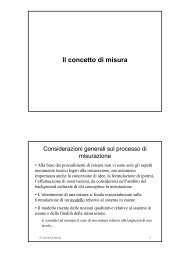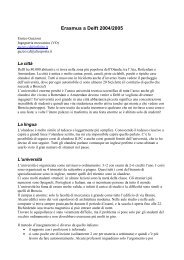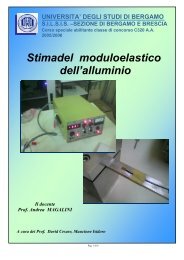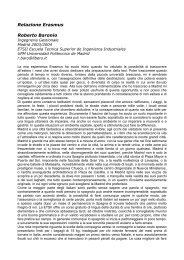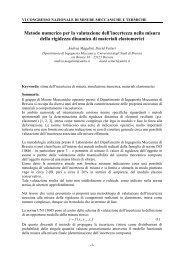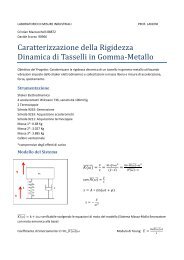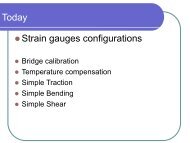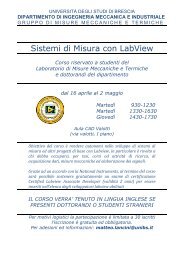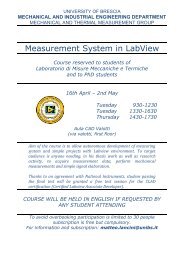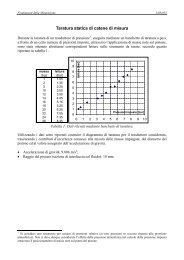Caratteristiche dinamiche degli strumenti di misura - ArchiMeDes
Caratteristiche dinamiche degli strumenti di misura - ArchiMeDes
Caratteristiche dinamiche degli strumenti di misura - ArchiMeDes
Create successful ePaper yourself
Turn your PDF publications into a flip-book with our unique Google optimized e-Paper software.
3 - Ra<strong>di</strong>ci complesse coniugate<br />
Per ogni ra<strong>di</strong>ce λ i che assume valore α i ± jω i si considera un termine del tipo:<br />
che equivale a:<br />
αit<br />
[ C ω t)<br />
+ C cos( ω t)<br />
] ⋅e<br />
1 sin( i 2<br />
C sin( ω t + ϕ ) ⋅e<br />
4 - Ra<strong>di</strong>ci complesse coniugate con molteplicità r<br />
i<br />
i<br />
Per ogni ra<strong>di</strong>ce λ i che assume valore α i ± jω i con molteplicità r si considera un<br />
termine del tipo:<br />
r−1<br />
αit<br />
[ C ω t ϕ ) + C t sin( ω t + ϕ ) + ... + C t sin( ω t + ϕ ) ] ⋅e<br />
0 sin( i + 1 1 i 2<br />
r−<br />
1<br />
i r−1<br />
<strong>Caratteristiche</strong> <strong><strong>di</strong>namiche</strong> 5<br />
• Integrale particolare:<br />
Si può ottenere me<strong>di</strong>ante il metodo dei coefficienti indeterminati. Si ipotizza<br />
una funzione in cui compaiono un numero adeguato <strong>di</strong> coefficienti incogniti.<br />
Sostituendo tale funzione in qo nell’equazione <strong>di</strong>fferenziale <strong>di</strong> partenza si<br />
ricavano i valori da attribuire a tali coefficienti.<br />
In particolare, se al secondo membro dell’equazione <strong>di</strong>fferenziale <strong>di</strong> partenza,<br />
vi è una funzione F(t),<br />
- se F(t) è una funzione polinomiale <strong>di</strong> grado n <strong>di</strong> t, qp (t) è un polinomio <strong>di</strong><br />
grado n+r, dove r è la molteplicità della soluzione λ=0 nell’omogenea<br />
associata.<br />
- se F(t) è una funzione armonica del tipo A'sin(<br />
kx)<br />
:<br />
qp (t) è del tipo A cos( kt)<br />
+ Bsen(<br />
kt)<br />
se ±ik non è soluz. dell’omogenea<br />
associata<br />
r<br />
qp (t) è del tipo [ Acos( kt)<br />
+ Bsen(<br />
kt)<br />
] ⋅t<br />
se ±ik è soluz. <strong>di</strong><br />
molteplicità r dell’omogenea associata<br />
<strong>Caratteristiche</strong> <strong><strong>di</strong>namiche</strong> 6<br />
i<br />
i<br />
αit




